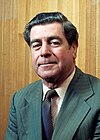Third Whitlam ministry | |
|---|---|
| 49th Ministry of Australia | |
 The third Whitlam ministry meeting at Old Parliament House, Canberra, in 1974 | |
| Date formed | 12 June 1974 |
| Date dissolved | 11 November 1975 |
| People and organisations | |
| Monarch | Elizabeth II |
| Governor-General | Sir Paul Hasluck Sir John Kerr |
| Prime Minister | Gough Whitlam |
| Deputy Prime Minister | Jim Cairns Frank Crean |
| No. of ministers | 31 |
| Member party | Labor |
| Status in legislature | Majority government |
| Opposition party | Liberal–National Country coalition |
| Opposition leader | Billy Snedden Malcolm Fraser |
| History | |
| Election | 18 May 1974 |
| Legislature term | 29th |
| Predecessor | Second Whitlam ministry |
| Successor | First Fraser ministry |
| ||
|---|---|---|
Term of government (1972–1975)
Ministries Elections Related | ||
The third Whitlam ministry (Labor) was the 49th ministry of the Government of Australia. It was led by the country's 21st Prime Minister, Gough Whitlam. The third Whitlam ministry succeeded the Second Whitlam ministry, which dissolved on 12 June 1974 following the federal election that took place in May. The ministry was replaced by the First Fraser Ministry on 11 November following the dismissal of the Whitlam government by the Governor-General, Sir John Kerr. [1]
Contents
The order of seniority in the third Whitlam ministry was determined by the order in which members were elected to the Ministry by the Caucus on 10 June 1974, except for the four parliamentary leaders.
As of 21 October 2023, Doug McClelland and Paul Keating are the last surviving members of the third Whitlam ministry.
































